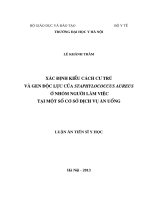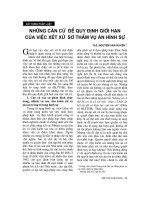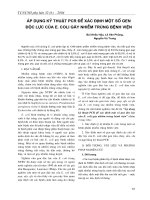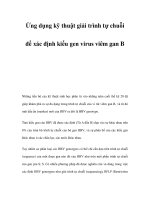chuyên đề xác định kiểu cách cư trú và gen độc lực của staphylococcus aureus ở nhóm người làm việc tại một số cơ sở dịch vụ ăn uống bản tóm tắt tiếng anh
Bạn đang xem bản rút gọn của tài liệu. Xem và tải ngay bản đầy đủ của tài liệu tại đây (856.08 KB, 29 trang )
MINISTRY
OF EDUCATION AND TRAINING
MINISTRY
OF HEALTH
HANOI MEDICAL UNIVERSITY
LE KHANH TRAM
DETERMINATION OF CARRIER STATUS
AND TOXIN GENES OF Staphylococcus aureus
IN FOOD HANDLERS
Specialization: MEDICAL MICROBIOLOGY
Code: 62720115
PHD MEDICAL THESIS SUMMARY
HANOI-2013
THE WORKS WERE COMPLETED
AT THE HANOI MEDICAL UNIVERSITY
Supervisors:
1. Assoc. Professor Dinh Huu Dung, MD, PhD
2. Assoc. Professor Nguyen Vu Trung, MD, PhD
Referee 1: Assoc. Professor, PhD. Le Van Phung
Referee 2: Assoc. Professor, PhD. Nguyen Thi Khanh Tram
Referee 3: PhD. Tran Huy Thinh
Examination committee: Institutional Dissertation Council, Hanoi
Medical University
Examination date:
The thesis can be found at:
1. National library.
2. Central library of medicine information
3. Library of Hanoi Medical University,
SCIENTIFIC PUBLICATIONS RELEVANT
TO THE THESIS
1. Le Khanh Tram, Dinh Huu Dung, Nguyen Vu Trung
(2011), Determination of carriage prevalence and carrier
status of Staphylococcus aureus, Journal of medical
research, 77 (6), pp. 29-33.
2. Le Khanh Tram, Dinh Huu Dung, Pham Thi Thuy
Duong, Nguyen Vu Trung (2012), Distribution of
coagulase gene in genotypes of Staphylococcus aureus,
Journal of medical research, 78 (1), pp. 1-5.
3. Le Khanh Tram, Dinh Huu Dung, Nguyen Vu Trung
(2012), Detection of enterotoxin genes in Staphylococcus
aureus strains, Journal of medical research, 80 (3),
pp. 11-16.
4. Le Khanh Tram, Pham Thi Thuy Duong, Dinh Huu Dung,
Nguyen Vu Trung (2010), Determination of carriage
prevalence and classification of Staphylococcus aureus based
in coagulase encoding gene of staffs working in restaurants in
Hanoi, at 16
th
Scientific Conference for PhDs, Hanoi Medical
University, Won the third prize.
5. Le Khanh Tram, Nguyen Vu Trung, Dinh Huu Dung
(2011), Detection of enterotoxin genes in Staphylococcus
aureus strains, at 17
th
Scientific Conference for PhDs, Hanoi
Medical University, Won the third prize.
1
INTRODUCTION
Staphylococcus aureus is a member of the bacterial flora in
humans. About 30% of healthy people carry S. aureus. These
bacteria can be found in many areas of human body such as on skin
of the necks, chest, abdominal, hands…and many natural cavities of
the body, especially the anterior nares. S. aureus can be persistent,
intermittent or non- carry on the human body. When there were skin
lesions, destroyed mucous membranes, the immunity defence of body
would decrease, giving the opportunities for the infection by S.
aureus. The presence and number of S. aureus in the body depends
on the immune status, sanitation, and many other factors of the hosts
as well as the bacteria.
S. aureus is one of the leading causes of food poisoning throughout
the world and it is still an unresolved problem. Food poisoning caused
by S. aureus accounted for about 25% of cases and 10% of patients
hospitalized for food poisoning treatment. There have been severe cases
of danger to life in Vietnam. S. aureus is the main cause of
contamination in food. Due to the hot and humid climate, the lack of
appropriate storage conditions, the presence of S. aureus with high
numbers in foods would potentially lead to the break out of food
poisoning, and consequently affect the economy. The individuals
working in the close contacts with food such as food processing, food
saling would be highly potential sources of contaminating S. aureus for
processing, manufacturing, packaging, transportation and storage of
food. In Vietnam there have been many studies on the pathogenicity and
antibiotic resistance of S. aureus but, no research on carrier status as
well as very low number of studies on toxin genes carried of these
pathogen.
Thus, our study with the title: “Determination of carrier
status and toxin genes of Staphylococcus aureus in food handlers”
with the following two main purposes:
1. To determine the carriage prevalence and the carrier status
of Staphylococcus aureus in the nose and hands of staffs working in
restaurants in Hanoi.
2. To determine the distribution of coagulase gene polymorphism
2
and enterotoxins genes of the isolated S. aureus strains.
NEW CONTRIBUTIONS OF THE THESIS
1. This is the first study on the carrier status of S. aureus in healthy
people in Viet Nam.
2. Providing scientific information contributing to the carriage
prevalence of Staphylococcus aureus of food handlers working
in restaurants in Hanoi.
3. This is the first study in Viet Nam on coagulase and enterotoxin
coding genes of S. aureus isolated from noses and hands of food
handlers working in restaurants in Hanoi.
4. Providing a better understanding in molecular epidemiology of
coagulase and enterotoxin coding genes of S. aureus.
THE LAYOUT OF THE DISSERTATION THESIS
The thesis comprises of 117 pages. Introduction 2 page; the
conclusions 1 page; recommendations 1 page. The main content is
divided into four chapters: Chapter 1: overview (35 pages); Chapter
2: the object and methodology (20 pages); Chapter 3: study results
(27 pages); Chapter 4: discussion (30 pages); There are 40 tables, 13
figures and 7 charts, appendices and 131 references of those 28 were
in Vietnamese and 103 were in English.
CHAPTER 1
OVERVIEW
1.1. MICROFLORA IN HUMAN
Normal microflora in human (normal microbial flora) is the
complex of microorganisms that live on the healthy human body.
Microflora on skin contains mainly Gram-positive bacteria, which
are usually Staphylococci (Staphylococcus epidermidis), anaerobic
bacteria (Propionibacterium acnes which cause acne). There is also
3
the Staphylococcus aureus, Streptococcus viridians, Bacillus like
diphtheria and spore bacteria in the air. It is accounted for about 10
10
bacteria on the skin. Normal microflora in narses are staphylococci
and streptococci, Corynebacterium, especially the S. aureus that have
the ability to infect and spread.
1.2. CHARACTERISTICS OF S. aureus
S. aureus is a Gram-positive cocci, with a diameter of 0.8-1 μm,
grouping into the form of grapes, no pilli, no spore and usually no
capsula. S. aureus can be easily cultivated, they grow at a
temperature of 10
0
C-45
0
C and salt concentrations as high as 10%,
appropriate in both anaerobic and aerobic conditions. The genome of
S. aureus is completely sequenced in size from 2820 to 2903 bp. G, C
contain is around 33% and from 2592 to 2748 bp sequence encodes
for proteins. In the genome, 75% of the sequences is highly
conserved between the strains of S. aureus. The set of all the
sequences of genomic region is called core genome.
1.3. CARIAGE PREVALENCE AND CARRIER STATUS OF S.
aureus
S. aureus is a member of the bacterial flora in humans. About
20-30% of healthy people carry S. aureus. Long time ago, the
relationship between carriers of bacteria and food poisoning caused
by S. aureus was mentioned and studied, particularly in those who
having direct contact with food during the processes of production,
processing, transportation, distribution and storage of food. These
bacteria can be persistent, intermittent on the host body. Also, in
some individuals the existence of these bacteria has not been found.
Carriage prevalence of S. aureus among food handlers is about 20-
40% according to several different studies. The strains of S. aureus
4
isolated from food handlers also possessed a high rate of antibiotic
resistance and contained the toxin genes such as the enterotoxin
genes se: sea, seb, sec, sed, see (80-90%).
1.4. THE PATHOGENIC FACTORS OF S. aureus
There are many factors affecting to the establishment of
pathogenicity in S. aureus. These can be divided into three groups:
cell surface-associated, extra cellular proteins and others.
1.4.1. Cell surface-associated protein: peptidoglycan, teichoic acid,
protein A, capsula, adhesins
1.4.2. Extra cellular proteins: enterotoxins, toxic shock syndrome
toxin, hemolyasin, exfoliatin
1.4.3. Other pathogenic factors: coagulase, alpha toxin, leukocidin,
staphylokinase enzymes, Panton-Valentine leukocidin,
staphyloxanthin, some of others extracellular enzymes
1.5. TOXIN GENES OF S. aureus
Pathogenic factors of S. aureus are controlled by a gene or some
genes directly or indirectly through enzymes. In this study we just
focused on the toxin genes of importance in these bacteria.
1.5.1. Coagulase encoding gene of S. aureus
The coagulase gene of S. aureus has 6 basic segments. The
signal chain of the sequence starting at the N-end to the D1, D2
regions, central region, the repeated region (segments with 81 bp
nucleotid), and the C-end. The classification of the genotype of
coagulase gene in S. aureus based on the polymorphism of the DNA
fragments treated by the restriction enzyme AluI has a number of
advantages in the S. aureus strain identification such as simplicity,
5
fast, and accuracy.
1.5.2. Enterotoxin genes of S. aureus
Enterotoxin genes of S. aureus such as sea, seb, sec… encode
for more than 20 different types of enterotoxins. Most of the genes
coding for enterotoxins have been identified in the mobile genetic
factors such as plasmids, bacteriophages. Moreover, the pathogenic
genes can be scattered or concentrated into a group called enterotoxin
gene cluster. Thus, horizontal transmission of these genes between S.
aureus strains is common.
1.6. S. aureus INFECTIOUS DISEASES
Accoding to the statistic data of the 16 common disease-causing
bacteria in Vietnam, the rate of S. aureus constitutes from 18.5-
21.7%, ranking second only to E. coli. S. aureus can cause several
clinical diseases such as infections affecting skin and soft tissues,
scalded skin syndrome, infection of bones and joints, endocarditis,
bacteraemia, pneumonia, food poisoning and intestinal infections,
toxic shock syndrome and nosocomial infections.
1.7. LABORATORY ISOLATION AND IDENTIFICATION OF
S. aureus
1.7.1 Common techniques to identify S. aureus: direct microscopic
examination; isolation, cultivation, and identification slide;
aglutination, ELISA, identification by phages.
1.7.2. Molecular biology techniques: molecular biology techniques
have been applied more and more in the diagnosis and study of S.
aureus. These methods are faster, less costly in some cases. In
particular, these techniques give results with high sensitivity,
specificity such as PCR, realtime PCR, nested PCR, RFLP, PFGE,
6
MLST, gene sequencing.
CHAPTER 2
OBJECTS, MATERIALS AND METHODS
2.1. OBJECTS
2.1.1. Research object of carriage prevalence and carrier status
of S. aureus
- Selection criteria: employees working at 14 restaurants in
Hanoi have direct contact with food.
- Exclusion criteria: employees who do not voluntarily
participate in all 4 sampling times, who have acute or chronic or
diseases of nose, throat, skin inflammation, infections of the skin
and hands, nails, who is taking antibiotics or immune suppressing
drugs.
2.1.2. Study objects for the distribution of toxin genes of S.
aureus
All S. aureus strains isolated from employees.
2.2. RESEARCH METHODS
2.2.1. Study design: This is a cross-sectional study which has been
described previously.
2.2.2. Sample size and sample selection
- Sample size: n = Z
2
1-α/2
p (1-p)/(εp)
2
n: sample size for the research; Z: coefficient of reliability,
with α = 0.05 then Z
1-α/2
= 1.96
p: carriage prevalence of S. aureus in food handlers
according to previous studies (33%);
ε: accuracy relative to p, ε = 0.2, n = 195. Number of
eligible objects are studied was 212.
7
The objects were selected as random individuals.
- The isolated S. aureus strains are studied in coagulase and
entrerotoxin coding genes.
2.4. RESEARCH TECHNIQUES
2.4.1. Sampling:
Samples in the nose and hands of each participants will be
collected by using sterile swabs 4 times with one week intervals to
determine the carriage prevalence and carrier status of S. aureus.
2.4.2. Isolation and identification of S. aureus:
According to the microbiological procedures, the properties
will be used for the identifiction of S. aureus included:
+ Gram-positive cocci grouped into grapped-form clusters.
+ Enzyme coagulase.
+ Enzyme catalase
+ Fermentation of manitol
2.4.4. PCR for identification of toxin genes
2.4.4.1. DNA extraction (DNA QIAGEN QIAamp Minikit 50)
2.4.4.2.PCR for identification of coagulase gene polymorphism
(according to the procedures described by Goh et al.)
4 sets primers:
COAG1:5’-ATACTCAACCGACGACACCG-3’
COAG2: 5’-CGAGACCAAGATTCAACAAG-3’
COAG3: 5’-AAAGAAAACCACTCACATCA-3’
COAG4: 5’-GATTTTGGATGAAGCGGATT-3’
The PCR products were treated with restriction enzymes AluI
8
2.4.4.3. Identification of enterotoxin coding genes (se).
Table 2.1: Primer sets for se genes
Gene
Primer
name
Nucleotide sequence (5’-3’) Reference
sea
SEA-1
SEA-2
tggaaacggttaaaacgaa
gaaccttcccatcaaaaaca
Johnson et al.
(1991)
seb
SEB-1
SEB-2
tcgcatcaaactgacaaacg
gcaggtactctataagtgcc
Johnson et al.
(1991)
sec
SEC-1
SEC-2
gacataaaagctaggaattt
aaatcggattaacattatcc
Johnson et al.
(1991)
sed
SED-1
SED-2
ctagtttggtaatatctcct
taatgctatatcttataggg
Johnson et al.
(1991)
see
SEE-1
SEE-2
aggttttttcacaggtcatcc
cttttttttcttcggtcaatc
Merhotra et al.
(2000)
seg
SEG-1
SEG-2
aagtagacatttttggcgttcc
agaaccatcaaactcgtatagc
Omoe et al.
(2002)
sei
SEI-1
SEI-2
ggtgatattggtgtaggtaac
atccatattctttgcctttaccag
Omoe et al.
(2002)
sej
SEJ-1
SEJ-2
catcagaactgttgttccgctag
ctgaattttaccatcaaaggtac
Nashev et al.
(2004)
2.6. CARRIER STATUS OF S. aureus
Table 2.8: Evaluation standards to determine carrier status
of S. aureus
Number of sampling with S. aureus Carrier status
4/4 of the test results Persistent
1 – 3/4 of the test results Intermittent
0/4 of the test results Non-carry
2.7. TIME PERIOD AND STUDY SITE:
The study was conducted from July 2009 to March 2012 at the
Microbiology Department, Hanoi Medical University and Clinical
9
laboratories of National Hospital of Tropical Diseases in Hanoi,
Vietnam.
2.8. ANALYTICAL METHOD AND DATA PROCESSING
+ The data are processed by using software SPSS 16.
+ Test χ
2
is used to compare the difference between the two rates.
Value of p<0.05 is considered the statistically significant differences.
CHAPTER 3
RESULTS
3.1. CARIAGE PREVALENCE AND CARRIER STATUS OF S.
aureus
3.1.1. Characteristics of study object
3.1.1.1. The distribution of subjects by gender
Table 3.1: Distribution of subjects by gender
Gender n %
Male 112 52.83
Female 100 47.17
Total 212 100.00
Among 212 employees participated in the study, the percentage
of male was 52.83% and female was 47.17%.
3.1.1.2. Distribution of subjects by age
Table 3.2: Distribution of research subjects by age
Age group n %
≤ 19 42 19.81
20-29 140 66.04
30-39 17 8.02
40-49 9 4.24
≥ 50 4 1.89
Total 212 100.00
The age group from 20 to 29 account for the highest percentage
10
(66.04%) among the total number of participates. The second was the
group ≤ 19 years, constituted in 19.81%. Finally the group ≥ 50 was
the lowest with 1.89%.
3.1.2. Carriage prevalence of S. aureus and relevant factors
3.1.2.1. Carriage prevalence of S. aureus
Chart 3.1: Carriage prevalence of S. aureus among the 212
individuals involving in the study
3.1.3. Carriage prevalence and carrier status of S. aureus in nose
and relevant factors
3.1.3.1. Carriage prevalence and carrier status of S. aureus in nose
11
Chart 3.2: Carriage prevalence and carrier status
of S. aureus
in nose among the 212 individuals involving in the study
3.1.3.2. Carriage prevalence and carrier status of S. aureus in nose
by gender
Chart 3.3: Carriage prevalence and carrier status of S. aureus in
nose by gender
Intermittent carriage of S. aureus was higher in females than in
males (29% vs. 12.5%), whereas persistent prevalence was higher in
males than females (1.79% vs. 1%). This difference is statistically
significant with p < 0.05.
3.1.3.4. Carriage prevalence and carrier status of S. aureus in nose
by working sections
p<0,05
%
%
12
Chart 3.4: Carriage prevalence and carrier status of S. aureus in
nose by working sections
Intermittent carriage of S. aureus in the nose was the highest in
group of waiters and waitresses (29.41%), the lowest was in the
group of cooks (10.13%). Persistent carriage in these two groups was
1.96% and 1.27%, respectively. This difference is statistically
significant with p < 0.05.
3.1.4. Carriage prevalence of S. aureus in hands
3.1.4.1. Overall carriage prevalence of S. aureus in hands
Table 3.14: Carriage prevalence of S. aureus in hands
Carrier status n %
Non carrier 193 91.04
Intermittent 19 8.96
Total 212 100.00
The carriage prevalence of S. aureus in hands was 8.96%, no
person carries these bacteria persistently in hands.
3.2. STUDIES ON TOXIN GENES OF S. auresus
101 strains of S. aureus including, 77 strains from nose and
24 strains from hands, were isolated and subjected to the study on
p<0,05
13
toxin genes.
3.2.1. Coagulase gene polymorphism of S. aureus strains
3.2.1.1. Distribution of genotype of coagulase gene of S. aureus
20 genotypes were identified based on the length of DNA
fragments obtained after digestion of the gene sequence by restriction
enzyme AluI. The most frequent was genotype 6 (53.47%) which
included 3 DNA fragments 465 bp, 250 bp and 165 bp. The second
was genotype 12 (6.93%) and the third was genotype 1 and genotype
2 (5.94%). The four genotypes have been accounted for nearly 75%
of the total number of strains.
Table 3.23: Distribution of genotype of coagulase gene
in 101 isolated S. aureus strains
Genotype
Number offragments
800 bp
550 bp
465 bp
250 bp
165 bp
85 bp
n
%
1 1 + 6 5.94
2 2 + + 6 5.94
3 2 + + 3 2.97
4 2 + + 2 1.98
5 2 + + 1 0.99
6 3 + + + 54 53.47
7 2 + + 1 0.99
8 2 + + 1 0.99
9 2 + + 3 2.97
10 3 + + + 2 1.98
14
Genotype
Number offragments
800 bp
550 bp
465 bp
250 bp
165 bp
85 bp
n
%
11 3 + + + 3 2.97
12 3 + + + 7 6.93
13 3 + + + 2 1.98
14 3 + + + 2 1.98
15 3 + + + 1 0.99
16 3 + + + 1 0.99
17 4 + + + + 1 0.99
18 4 + + + + 3 2.97
19 4 + + + + 1 0.99
20 4 + + + + 1 0.99
Total 101 100,00
3.2.1.3. Distribution S. aureus-harboring staffs according to the
number of the genotype of coagulase gene
Table 3.25: Distribution S. aureus-harboring staffs by the number
of the genotype of coagulase gene
Number of genotypes S. aureus-harboring staffs (%)
1 39 73.58
2 13 24.53
3 1 1.89
4 0 0.00
15
Total 53 100.00
S. aureus carriage prevalence with 1 genotype of the gene
encoding coagulase was the most common, 73.58%. The prevalence
with 2 genotypes constituted 24.53%. Only one S. aureus-harboring
staff showed 3 different genotypes, constituted 1.89%.
3.2.2. Study on enterotoxin genes of S. aureus
3.2.2.1. Overall carriage prevalence of enterotoxin genes of
S. aureus
Table 3.26: Overall carriage prevalence of enterotoxin genes of
S. aureus
Carrying gene n %
Carrying 64 63.37
Non carrying 37 36.63
Total 101 100.00
The overall carriage prevalence of enterotoxin genes of S.
aureus accounted for 63.37%.
3.2.2.2. The distribution rate of S. aureus strains according to the
type of enterotoxin genes
16
Chart 3.6: Distribution rate of S. aureus strains according to the
type of enterotoxin genes
M: marker, NC: negative cotrol, PC: positive control
Figure 3.7: PCR products of gene sei of some S. aureus strains
Among of the genes encoding classical entrotoxins in S. aureus
(sea-see), the sec appeared most frequently (21.82%), followed by
the sea (13.64%), seb (11.82%) and sed (2.73%). With regard to the
genes coding for new enterotoxin genes (seg, sei, sej), seg constituted
the highest rate (20.91%), followed by the sei (13.64%). There is no
strain carrying the gene sej.
3.2.2.4. The distribution rate of S. aureus strains according to the
number of enterotoxin genes
Chart 3.7: Distribution rate of S. aureus strains according to the
1000 bp
454 bp
17
number of enterotoxin genes
30/64 strains (46.88%) carried just one gene, 24/64 strains
(37.5%) carried two gene, 7/64 strains (10.94%) carried three genes
and 3/64 strains (4.69%) carried four genes.
CHAPTER 4
DISCUSSION
4.1. CARIAGE PREVALENCE AND CARRIER STATUS OF S. aureus
4.1.1. Some characteristics of the research object
In this study, men were presented more than women (52.83% vs
47.17%, respectively). This is different from other studies, which
were carried out with higher number of female than male, such as the
study of Gashaw on café serving staffs (63% and 37%), the study of
Oteri on 161 staffs of food handlers with 57.1% female and 42.9%
men. Concerning the age of participants in the present research, the
majority group was of people at the age 20 to 29 (accounting to
66.04%). This is the age of good health, and capability of active
labor. This result was similar to that in the study of Gashaw 2008.
4.1.2. Overall carriage prevalence of S. aureus and related factors
In this study, the percentage of people who carried S. aureus
counted for 25%, similar to the study of Bustan (26.6%) on 500 staffs
in restaurants in Kuwait, however was lower than Jonge's research in
the Netherlands in 2010 (33%) and research of Borges in 2010 in
Brazil (36%). It should be noted that here the carrier status of S.
aureus was determined as the analyses results of 4 times of sampling,
whereas the others studies based only on 1 time sampling. The
carriage prevalence of S. aureus found in this research was in the
range of normal limits (20-70%). The differences of prevalence may
be due to the study subject, races or geographical regions.
18
4.1.3. Carriage prevalence and carrier status of S. aureus in the
nose and relevant factors
In this study, the carriage prevalence of S. aureus in the nose
was 21.7%, the intermittent carriage was 20.28% and the persistent
carriage was 1.42%. It has been reported by other authors that the
carriage prevalence of S. aureus in the nose ranged from 12-30%,
depending on geographical regions and races. Comparing with other
studies, the carriage prevalence of S. aureus in the nose found in this
research was similar to that (21.6%) reported by Humodi, who
carried out a study on employees in food processing and service
sectors in Sudan (2010). However it was higher than that of (10.4%)
in the study of Haluk (2010); and carried out on 250 restaurant staffs
in Turkey and was lower than some other reports such as by Oteri in
Nigeria (1989) with 24% and by Garcia in Spain (1986) with 27%.
As shown in the chart 3.3, the carriage prevalence of S. aureus
in the nose was significantly higher in females than in males (29%
and 12.5%), whereas the persistent carriage was higher in males than
in females (1.79% and 1%). These differences were statistically
significant with p < 0.05. Concerning the carriage prevalence among
the female and male of both persistent and intermittent (30% and
14.29%), our findings were equivalent to the results published by
Oteri (1989) in Nigeria with 31.5% and 13.8%, respectively. In this
study, the carriage prevalence in female (33.3%) was much higher
than in male (17.4%). Similarly, Tammelin has found a lower
carriage prevalence in men than in women among medical staffs. It
could be noted that the carriage prevalence of S. aureus varied in the
dependence of countries around the world.
Regarding the correlation between the carriage prevalence an
the working section, it has been shown that the intermittent carriage
of S. aureus in the nose among waiters and waitresses was highest
(29.41%) (Chart 3.4). Moreover, the persistent carriage in waiters and
waitresses was 1.96%, higher than that in cooks 1.27% with the
19
difference was statistically significant with p < 0.05. These findings
were different from that reported in the sudy of Humodi (2010) in
Sudan with higher carriage prevalence of S. aureus in food-
processing workers than in the service and food distributing groups.
This difference could be explained basing on the proportional
structure of our study objects, in which the staffs working in food
processing accounted for smaller proportion in the total number of
employees 79/212 (37.26%), whereas in the study of Humodi, staffs
in food processing were 152/259 (58.69%).
4.1.4. Carriage prevalence of S. aureus in hands and relevant
factors
The carriage prevalence of S. aureus in hands was low (8.96%)
and no persistent carrier was found in the study. This could be results
of the general hygiene conditions of employees such as regular hand-
washing, responsibility of staffs for food safety, good sanitation
conditions in the working environments. In case some employees
could wash their hands just before sampling, the results would not be
interfered since the sampling was performed 4 times with one week
intervals. Table 4.1 shows the carriage prevalence of S. aureus in
hands from different studies. Thus, the results obtained in our study
(8.96%) was comparable to those recently reported by Sospedra
(2012) in a study on 227 samples from hands of food handlers (8.4%)
in Spain. However, it was higher than reports of some other authors
such as Haluk (5.6%), Borges (2010) in Brazil (2.9%) and of Nguyen
Hung Long et al. (2009) in Vietnam (3.3%). In the same time, this
value was lower than that reported by Gashaw (16.5%), Soares
(16.5%) and Zaglol (17.5%). In the latter studies, the carriage
prevalence of S. aureus in hands was high because the study was
carried out on people selling food on the streets, who did not have
health care, had no training on food safety, and might not perform
hand hygiene as required. Nevertheless, the sampling procedure in
this study (4 times of sampling with one week intervals) could be
good explanation for the high accuracy of the results in comparison
20
to one time sampling procedure in other studies.
Table 4.1: Reports on the carriage prevalence of S. aureus
in hands of food handlers
Author Year Country
Carriage
prevalence of
S. aureus in
hands
The present study 2012 Vietnam 8.96
Gashaw Andargie 2008 Ethiopia 16.5
Soares M.J. 1997 Brazil 16.5
Zaglol D. A. 2011 Saudi Arabia 17.5
Sospedra 2012 Spain 8.4
Haluk 2010 Turkey 5.6
Borges J. L. 2010 Brasil 2.9
Ly Thanh Minh 2007 Vietnam 49.6
Nguyen Thi Ngoc Hue 2009 Vietnam 31.8
Nguyen Hung Long 2009 Vietnam 3.3
4.2. TOXIN GENES OF S. aureus
4.2.1. The gene encoding coagulase
4.2.1.1. Coagulase gene polymorphism
Our research provided an additional evidence of the
polymorphism of the gene encoding coagulase in S. aureus,
consistent with many other studies around the world. Stefano (2008)
in Italy has classified 25 strains of S. aureus into 16 different
genotypes. Rodrigues (2005) in Brazil found 49 genotypes among 64
strains of S. aureus. These two studies used the same method as we
used in the present study, i.e. the RFLP analyses with restriction
21
enzyme AluI. By using two restriction enzymes AluI and HaeIII for
the RFLP analyses, Su (1999) found 40 genotypes among 425 strains
of S. aureus. However, by using the enzyme HaeIII alone, Lawrence
in France identified 79 of 86 analyzed strains (90%) with the same
genotype. Nevertheless, according to several authors, there should
always be one or several dominant genotypes, like in the study Kitai
(52.9%), Rodrigues, Su, Hinmabindu (15.5%).
Table 4.2: Polymorphism of coagulase gene in different studies
Author Year Country
Number of
strains of
S. aureus
Number of
genotypes
The present study 2012 Vietnam 101 20
Moradi Stefano 2008 Italy 25 16
Elizabete Rodrigues 2005 Brasil 64 49
Su. C 1999 The USA 425 40
Hinmabindu 2009 India 66 19
Swee-han Goh 1992 Canada 69 19
Schwarzkopf 1994 Germany 30 6
The polymorphism of the gene encoding coagulase has been
determines not only in S. aureus strains isolated from human but also
from animals and in different geographical regions. The
identification of coagulase genotypes of the S. aureus has confirmed
to be simple, accurate and very valuable in the classification of the
strains of S. aureus. Determining coagulase genotypes of S. aureus is
considered as the basis to assess the molecular epidemiology of S.
aureus. In our study, the most predominated genotype is 6 with 3
DNA fragments, accounting for 53.47% of the total number of S.
aureus strains isolated.
4.2.1.2. Distrbution of genotypes of the coagulase gene among
study objects









